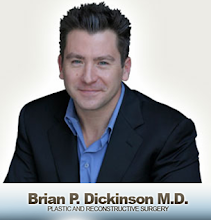Frequently, I encounter more women in consultation who present to my office desiring a revision of their
breast augmentation from 8 to 10 years prior. Frequently these women have had saline
breast implants in for almost ten years and now want to exchange their saline
breast implants for silicone
breast implants.
Often women who have had larger
implants and now want to downsize desire to have the breasts placed more centrally on their chest wall away from their armpits, with a reduction in the size of their areola, and a
lift of the breast.
Depending upon the age of the patient and whether or not she has had children and/or breast fed, the incision pattern used to make the breast appear more youthful depends upon the degree of
breast ptosis.
Breast ptosis or the "breast fall" can be corrected by different methods or incisions patterns depending upon the degree of
breast ptosis. The youthful appearance of the breast is best corrected by the relationship of the nipple areola complex to the breast crease or inframmary fold.
I use in consultation, the
breast ptosis method as classified by Regnault with modification: Grade 1 ptosis - The nipple areola complex has descend to the level of the inframammary fold. Grade 2 ptosis - The nipple areola complex has descended below the inframammary fold. Grade 3 ptosis - The nipple areola complex has descended below the inframammary fold with no lower pole tissue below nipple.
In general I have found that
Grade I ptosis can be corrected with the placement of an implant and/or a superiorly placed crescent mastopexy incision. Often a Benelli type mastopexy can be incorporated to reduced the diameter of the nipple areola complex.
Grade II ptosis often necessitates a vertical incision with/without a lateral limb extending from the nipple areola complex.
Grade III ptosis often requires a vertical component and horizontal component(s) to make the breast appear youthful.
As one can understand from the photograph above in the after picture on the left, the breast appears more youthful based on the relative size of the nipple areola complex and its position relative to the breast crease. Furthermore the breast has been centralized with its take-off no further lateral than the anterior axillary line. This position of the breast on the chest wall facilitates physical exercise. At three weeks post-operatively, I anticipate that the scars will soften and the swelling will subside giving an even more natural and youthful appearance to the breast as time progresses. Full post-operative change and swelling takes approximately 6 months to one year.
Brian P. Dickinson, M.D.
www.drbriandickinsonmd.com









 Proper nutrition should be an important part of everyone's daily life. Both aesthetic and reconstructive surgery place an increased metabolic demand on the body. It is important both pre-operatively and post-operatively to ensure adequate protein intake before and after surgery. Frequently nutrition comes up in consultations, so I have included below a standard post-operative diet protocol as well as an easy method for patients to understand the amount of protein they will need post operatively.
Proper nutrition should be an important part of everyone's daily life. Both aesthetic and reconstructive surgery place an increased metabolic demand on the body. It is important both pre-operatively and post-operatively to ensure adequate protein intake before and after surgery. Frequently nutrition comes up in consultations, so I have included below a standard post-operative diet protocol as well as an easy method for patients to understand the amount of protein they will need post operatively.








